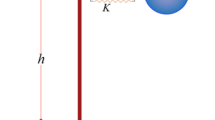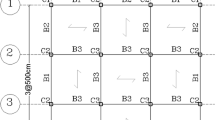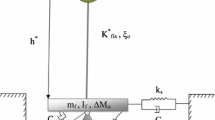Abstract
Inelastic displacement ratios have been generally investigated for fixed-base systems without taking into consideration soil structure interaction. In this study, inelastic displacement ratios are investigated for SDOF systems with period range of 0.1–3.0 s with elastoplastic behavior considering soil structure interaction for 64 different earthquake motions recorded on different site conditions such as rock, stiff soil, soft soil and very soft soil. Soil structure interacting systems are modeled with effective period, effective damping and effective ductility values differing from fixed-base case. For inelastic time history analyses, Newmark method for step by step time integration was adapted in an in-house computer program. Results are compared with those calculated for fixed-base case. A new equation is proposed for inelastic displacement ratio of interacting system as a function of structural period of interacting system \((\tilde T)\), ductility ratio (μ) and period lengthening ratio \((\tilde T/T)\). The fitness of the regressed function of the inelastic displacement factor is shown in figures. The regressed equation for \(\tilde C_\mu\) should be useful in estimating the inelastic deformation of structure where the global ductility capacity can be estimated.
Similar content being viewed by others
References
Applied Technology Council (ATC) (1984). Tentative provisions for the development of seismic regulations for buildings, Rep. ATC-3-06, California.
Applied Technology Council (ATC) (1996). Seismic evaluation and retrofit of concrete buildings, ATC-40, California.
Applied Technology Council (ATC) (2008). Quantification of building seismic performance factors, ATC-63, California.
Aviles, J. and Perez-Rocha, L. E. (2003). “Soil structure interaction in yielding systems.” Earthquake Engineering and Structural Dynamics, Vol. 32, No. 11, pp, 1749–1771.
Aviles, J. and Perez-Rocha, L. E. (2005). “Influence of foundation flexibility on R µ and C µ factors.” Journal of Structural Engineering, ASCE, Vol. 131, No. 2, pp. 221–230.
Bates, D. M. and Watts, D. G. (1988). Nonlinear regression analysis and its applications, John Wiley & Sons, Inc., New York.
Boore, D. M. (1993). “Some notes concerning the determination of shear-wave velocity and attenuation.” Proc. of Geophysical Techniques for Site and Material Characterization, pp. 129–34.
Chopra, A. K. and Chintanapakdee, C. (2004). “Inelastic deformation ratios for design and evaluation of structures: Single-degree-of-freedom bilinear systems.” Journal of Structural Engineering, Vol. 130, No. 9, pp. 1309–1319
Decanini, L., Liberatore, L., and Mollaioli, F. (2003). “Characterization of displacement demand for elastic and inelastic SDOF systems.” Soil Dynamics and Earthquake Engineering, Vol. 23, No. 6, pp. 455–471.
Federal Emergency Management Agency (FEMA) (2003). Recommended provisions for seismic regulations for new buildings and other structures, Rep. FEMA-450, Washington, D.C.
Ghannad, M. A. and Ahmadnia, A. (2002). “The effect of soil structure interaction on ductility demand of structure.” 12 th European Conference on Earthquake Engineering, London.
Lin, Y. Y. and Miranda, E. (2008). “Kinematic soil-structure interaction effects on maximum inelastic displacement demands of SDOF systems.” Bulletin of Earthquake Engineering, Vol. 6, No. 2, pp. 241–259.
Meek, J. W. and Wolf, J. P. (1992). “Cone models for homogeneous soil.” Journal of Geotechnical Engineering, ASCE, Vol. 118, No. 5, pp. 667–685.
Ministry of Public Works and Settlement (2007). Turkish seismic design code, Ankara (in Turkish).
Miranda, E. (2000). “Inelastic displacement ratios for structures on firm sites.” Journal of Structural Engineering, ASCE, Vol. 126, No. 10, pp. 1150–1159.
Muller, F. P. and Keintzel, E. (1982). “Ductility requirements for flexibly supported antiseismic structures.” Proc. of the Seventh European Conference on Earthquake Engineering, Vol. 3, pp. 27–34.
Ordaz, M. and Pérez-Rocha, L. E. (1998). “Estimation of strength reduction factors for elastoplastic systems: A new approach.” Earthquake Eng. Struct. Dyn., Vol. 27, No. 9, pp. 889–901.
Ruiz-Garcia, J. and Miranda, E. (2003). “Inelastic displacement ratios for evaluation of existing structures.” Earthquake Engineering and Structural Dynamics, Vol. 32, No. 8, pp. 1237–1258.
Ruiz-Garcia, J. and Miranda, E. (2004). “Inelastic displacement ratios for design of structures on soft soils sites.” Journal of Structural Engineering, ASCE, Vol. 130, No. 12, pp. 2051–2061.
Ruiz-Garcia, J. and Miranda, E. (2006). “Inelastic displacement ratios for evaluation of structures built on soft soils sites.” Earthquake Engineering and Structural Dynamics, Vol. 35, No. 6, pp. 679–694.
StatSoft Inc. (1995). STATISTICA V.6.0 for Windows. Tulsa, OK, USA.
Veletsos, A. S. (1977). “Dynamics of structure-foundation systems.” Structural geotechnical mechanics, W. J. Hall, Ed., Prentice-Hall, Englewood Cliffs, N.J., pp. 333–361.
Veletsos, A. S. and Meek, J. W. (1974). “Dynamic behavior of building-foundation systems.” Earthquake Engineering and Structural Dynamics, Vol. 3, No. 2, pp. 121–138.
Veletsos, A. S. and Nair, V. V. D. (1975). “Seismic interaction of structures on hysteretic foundations.” Journal of Structural Engineering, ASCE, Vol. 101, No. 1, pp. 109–129.
Veletsos, A. S. and Newmark, N. M. (1960). “Effect of inelastic behavior on the response of simple systems to earthquake motions.” Proc. of the 2nd World Conference on Earthquake Engineering, Vol. 2, pp. 895–912 Japan.
Veletsos, A. S., Newmark, N. M., and Chelapati, C. V. (1965). “Deformation spectra for elastic and elastoplastic systems subjected to ground shock and earthquake motions.” Proc. of the Third World Conference on Earthquake Engineering, Vol. 7, pp. 663–682 New Zealand.
Wolf, J. P. (1994). Foundation vibration analysis using simple physical models, Prentice-Hall, Englewood Cliffs, N.J.
Wolf, J. P. and Somaini, D. R. (1986). “Approximate dynamic model of embedded foundation in time domain.” Earthquake Engineering and Structural Dynamics, Vol. 14, No. 5, pp. 683–703.
Author information
Authors and Affiliations
Corresponding author
Rights and permissions
About this article
Cite this article
Eser, M., Aydemir, C. & Ekiz, I. Inelastic displacement ratios for structures with foundation flexibility. KSCE J Civ Eng 16, 155–162 (2012). https://doi.org/10.1007/s12205-012-1266-5
Received:
Revised:
Accepted:
Published:
Issue Date:
DOI: https://doi.org/10.1007/s12205-012-1266-5




